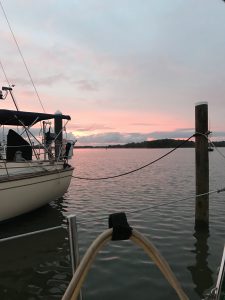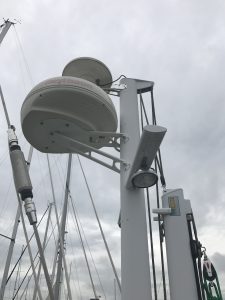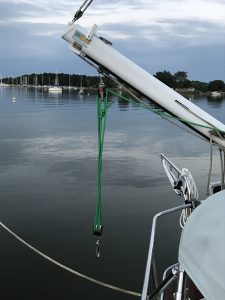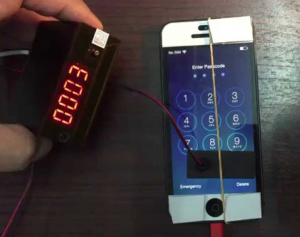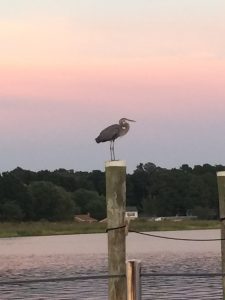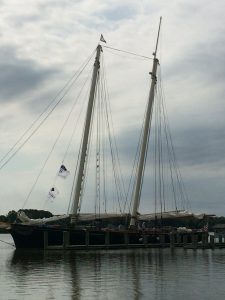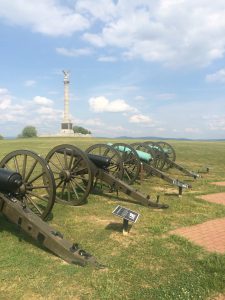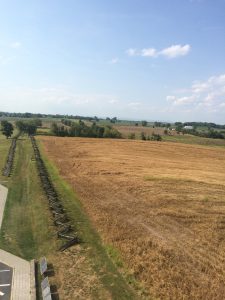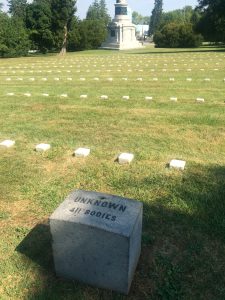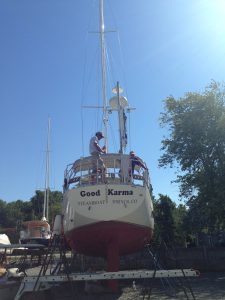Navigation Project Part 2
Radar Mast on Good Karma
Well, figuring out how marine electronics are supposed to work and coming up with a good installation layout is proving to be a challenge. Despite having an enormous amount of knowledge of electronics and computers, marine electronics are in their own special world. The things you’d think would be similar, such as a chart plotter and something like an iPad (both can be used as graphic navigation computers), are not at all.
By the way, this post will be quite boring to most so feel free to stop reading if you aren’t interested in this topic.
Also, wiring is a huge challenge. Ok, so you have a radar unit, which is the big round bowl-looking thing in the picture above, that works with the chart plotter. The chart plotter displays a chart (map) of the area and shows your boat location, like Google maps. Separately, the radar overlays on the map non-static items such as weather, boats, etc. Seeing where boats are is invaluable when navigating in fog or at night. For instance, when we sailed in the San Juan islands off Washington state, a fog bank came in rapidly while we were in a busy channel. Out of the gloom we heard a loud ship horn, ran to turn on the radar (an old clunky one) and could see where the ship was. We could then keep clear. So it is fairly important.
Anyway, the point is that the radar data has to get to the chart plotter which is in front of the wheel. To get the data to the chart plotter, you have to run a cable down the inside of the mast, under the cockpit deck and up to the chart plotter. Running these wires is quite the job. You would think a modern system would use wifi or bluetooth. You would think that all modern instruments would be connected this way, it would be far easier to install and maintain and maybe not quite as reliable, probably reliable enough.
Turns out the radar DOES have a wifi channel to the chart plotter BUT… They recommended wiring it up anyway and using the wifi as a “backup.” That actually makes no sense but whatever.
This all started because we wanted to install an AIS system so big ships can “see” us and we can “see” them. A new AIS required a new chart plotter which required a new radar. BUT, our current electronics are quite old and though they still work, they are very dated and it shows. A new system makes everything safer and given the amount of sailing we intend to do, we will need it.
By the way, click here to see a cool video of ship traffic around the world taken from AIS transponders. Lots of traffic out there!
Posted in Electronics and Radios, Sailing by Mark with comments disabled.
Busy Day
Hey Rocky Mountain Rescue, Do I Pass My RS Test?
A little inside joke there for the few RMR people who read this blog: What is shown is a new hauling system I rigged up today to lift our 90 pound dinghy outboard engine up to mount it on the stern rail. This system gives us a 4-to-1 mechanical advantage. An “RS test” is a grueling technical field test that Rocky Mountain Rescue uses to determine if someone is ready to move up to being in charge of the technical aspects of a mountain rescue mission. Building a hauling system, similar to what is shown above, is a standard part of the test. It is not so common to use these a haul system even in intermediate mountaineering, but in sailing they are one of the most basic systems, used in numerous applications.
On top of that we are beginning a major overhaul of our navigation electronics. We are installing a new chart plotter (kind of like Google Maps for the ocean), a new radar and an automated identification system (AIS). One thing an AIS does is to warn you if you are on a collision course with another vessel. This is important, especially in busy shipping lanes and in the ocean where a cargo ship could easily sneak up on you at night. It also tells other ships what your boat is doing and therefore warns them there may be a collision so that can either contact you or change course.
We struggled to gather all the components of this system (which all work together) and now are going to install them. It’ll probably take a few days but when we are done, we’ll have pretty much all the modern electronics we should need.
Posted in Mountain Rescue, Sailing by Mark with 2 comments.
Government Surveillance Demands
Yes, It Can Be Hacked!
For cyber security types, here is a good article providing evidence that the FBI’s arguments for coercing Apple to break into the San Bernardino terrorists iPhone 5c were essentially propaganda. The FBI appeared to use this case to lobby for federal legislation to require “backdoors” to be built into smartphones, etc., so that law enforcement can gain easy access to any device.
The story went like this: The FBI wanted access to one of the San Bernardino shooters iPhones so they could check up on contacts, emails, text messages, anything that would help the FBI discover a potential (but as yet unproven) network or other terrorist contacts. The iPhone in question was locked with a passcode and if you make too many wrong entries trying to guess the code, the iPhone will erase all it’s memory.
The FBI decided to ask Apple to unlock it. Apple said that the FBI mishandled the phone and prevented the phone from uploading its memory to the Apple cloud. Apple said it did not have a way to unlock the phone itself and this is very likely true. The FBI then asked Apple to use their intimate knowledge of the workings of the iPhone to figure out a way to unlock the phone, basically to hack into their own product. Apple refused. The FBI then went public and in a very high profile case, attempted to use legal means to force Apple to comply.
After a couple of weeks of very public bantering, the FBI claimed it found a way to hack into the phone and asked that the case to force Apple to break into it’s own product be dropped. Subsequently, the FBI made several well-publicized pleas to congress to come up with a law that would force companies to build in “backdoors” to their products so the FBI and other law enforcement would not have to resort to expensive hacking techniques or even necessarily get a warrant.
The argument they make is that it would be a valuable tool to prevent terrorism and crime. And maybe it would. But the complexities of this issue go far beyond the myopic FBI viewpoint. Here is why:
A backdoor is a cyber security term for a method to bypass a user’s security. You have your key to unlock your “front door,” and the FBI has a key (or method) to unlock a built-in “back door.” This would work if the FBI kept their key safe. But suppose they did not keep it safe? Suppose a future highly placed individual in the FBI decided to use these backdoor keys to gather compromising information about political figures in order to gain power. What would J. Edgar Hoover have done with such power? Or Vladimir Putin?
Apple was correct to deny the FBI their services. No one buys an Apple (or any other brand) product with an expectation that the manufacturer is going to hack it open on demand. Privacy is expected and the product should operate as intended. Also, engineers would have had to produce a new technique under coercion of the law. The FBI could likely then use this tool to break into any other iPhone as it desired (and the FBI confirmed they have many iPhones they want to open up). Can the government force a locksmith to create a two-key lock if the locksmith does not want to? Is that constitutional?
Ironically, when the news of this broke, techies on the internet were abuzz with an easy technique to break into the iPhone: Take it’s flash memory out, read it and “brute force” guess the password (try every one until you find it). This would prevent the memory from being erased. And this is exactly what the proof-of-concept paper referenced in the above hyperlink explains.
The FBI thought this technique was “impossible.” Apparently, engineers and hackers are now the power brokers in this country. 😉
Posted in Cyber Security, Hacking! by Mark with comments disabled.
New Edition of Colorado 14er Disasters

Has this hit the bookshelves in Colorado yet?
My publisher said it would probably be on bookshelves around mid-September. Curious as to whether anyone has seen this new edition yet.
Posted in Colorado 14er Disasters by Mark with comments disabled.
Back Home
A Frickin Heron!
Back on the Good Karma tonight after being gone for about 9 days. We aren’t completely back to normal as they still have a few maintenance items to finish up over the next few days. At least we can stay on the boat now, it’s back in the water and all the “furniture” is back in place. We had a good tour but got a bit tired of all the restaurant food.
Above is a photo of a heron that visits us every evening. Shelly named him Herman. At night he stands on the edge of the dock at the edge of the dock lights. He stands straight up looking for fish and is at least three feet tall. In the middle of the night he looks like some sort of scary alien just standing there. We’ve been trying to get a night pic of him but he’s very sensitive to motion around him and leaves if he sees us.
Part of our upgrade was an EPA approved composting head (the toilet) that sterilizes waste and allows you to discharge directly into the bay. This is a great advantage as you don’t have to pump out your waste holding tank at the dock service center every few days.
Below is a pic of (a replica of) the America, first boat to win the America’s Cup in 1851. The masts on this replica are actually made of wood, like the original.
Considering an Upgrade…
Posted in Sailing by Mark with 2 comments.
Antietam
Antietam Battlefield Memorial
Approximately nine months prior to the Gettysburg battle in the Civil War was the Antietam Battle, where on September 17, 1862, more than 22,000 were killed. More Americans died on this single day than any time previous or since. It is located about an hour drive south of Gettysburg.
Here again, the tactics of attacking in lines of side-by-side soldiers resulted in thousands of deaths and with no effect on the battle or war. This happened prior to Gettysburg but apparently no tactics were changed. Some of the soldiers from the Confederacy who had fought here returned many months later on their way to what would end up being Gettysburg. They found upon their return that many of the bodies had not been buried and had turned into skeletal remains lying in the open fields.
Overall, more people were killed in the three day Gettysburg battle, but the single day record happened here at Antietam Creek.
Sunken Road Runs Away From Camera on Left. This is Where Thousands of Confederates Were Slaughtered in a Union Flanking Manuever.
Posted in Journal by Mark with comments disabled.
Gettysburg
Shelly Reads the Gettysburg Address Memorial on Cemetery Hill
First stop on our tour was Gettysburg, Pennsylvania, less than two hours from Annapolis. Everyone reads about the famous Gettysburg Address given by Lincoln during the Civil War at the location of this battlefield, but visiting is an eye opener. The battle took place over a large area that is mostly a National Park today. You can drive or walk to the historic sites around the battlefield, which essentially surrounds the town, and learn many details of the battle.
One Section of the Gettysburg National Cemetery with 411 Unknowns
The thing that impressed me most was the battle tactics that resulted in around fifty thousand deaths in three days. Soldiers on both sides would march side by side, with no shielding at all, directly into enemy fire. This tactic was completely ineffective but resulted in the deaths of hundreds and thousands at a time. I am astounded that these generals did not change their tactics to prevent such needless slaughter.
The horror of the aftermath is almost unbelievable. The battle took place July 1-3, 1863. Almost every home in town was taking care of injured soldiers. It took months before all the bodies were buried, mostly in mass graves (which were reinterred years later).
Lincoln was invited to come and speak at the location of perhaps the most important Union victory battlefield location and showed up in November 1863. He gave his address at Cemetery Hill (not where the Gettysburg Address memorial is) and it became one of the most famous speeches in history, though at the time it was not considered very profound.
This was quite the lesson for someone who grew up far away in Colorado.
Lincoln Gave the Gettysburg Address Near The Flagpole (center of photo)
Posted in Journal by Mark with 2 comments.
The Big Maintenance Haul-Out
The Name Is Finally Official!
Haven’t posted anything for a while because we were on an extended road trip. Right after Labor Day we had the Good Karma hauled out to complete some maintenance items that our surveyed found when we bought the boat. They weren’t serious items but several of them required that the boat be out of the water. They use what is called a “travel lift” to raise the boat and wheel it to a back location in the boat yard. The boat is lowered on several stands which are surprisingly stable. Boat hauling is a common maintenance operation and many people here store their boats “on the hard” for the winter. For long term storage they actually shrink-wrap the entire boat, which puts a water- and sun-proof coating around the boat while not in use. We plan on being much further south before winter sets in here at Rock Hall.
Since we couldn’t be on the boat while they worked on it here, we decided to do a Civil War battlefield tour, coming next…
The Work Begins…
Posted in Sailing by Mark with comments disabled.
Windy Day
Cloud Bands at Outer Edge of Hurricane Hermine
Lots of wind this day while we were at dock. Blowing here on the outer edge of hurricane Hermine. We didn’t get any rain here though. It wasn’t a hurricane when it got this far north but quite interesting watching the cloud bands flow over. It was deliciously cool starting last night through today. This is what I consider to be perfect weather. I believe it will get warmer again over the next week but in general the temperature has been livable here in Maryland.
It was a good down day after two days of sailing and getting into the pace of our new life. This is Labor Day weekend and the little town of Rock Hall is rocking. Interesting to see how this town transitions from sleepy small colonial town during the week to busy tourist town on the weekends.
By the way, this was apparently one of the favorite stops for George Washington and there are signs all over declaring that George Washington slept here.
Posted in Sailing by Mark with 2 comments.
